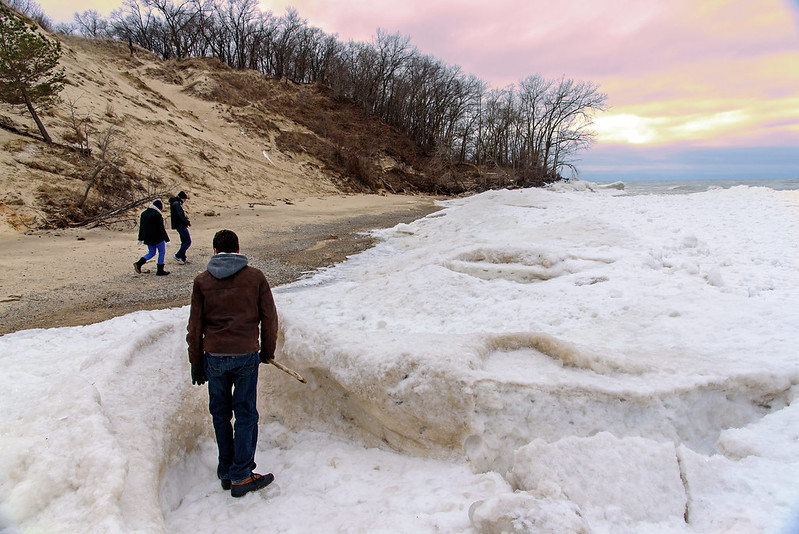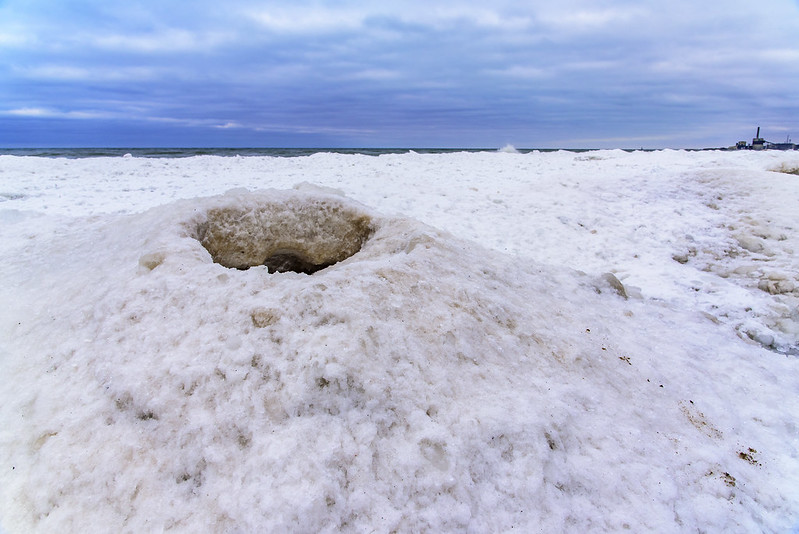
Each winter, the waves of Lake Michigan crash onto the beach and freeze into large ice mounds. Some years, these mounds can reach a height of 15 feet or more, and extend into the lake as far as the eye can see. This year, the ice isn't that tall or that wide, but it's still impressive if you walk along the shore.
Walking on this is can be deadly, and should never be done. Knowing this beach very well, and being able to read the shore and ice, I can tell the first ice mounds on the beach were actually on the shore and not over water. These mounds formed early, before any shelf ice formed into the lake, so the splashing water created mounds on the sand, a few feet from the water's edge. So, where we were standing in the photo above, was on the shore, and not over the water. If you're not familiar with the beach, don't even walk near this ice, the churning water can deposit sand and stones on the ice, making it appear as if you're walking on the sand, but in fact you're walking on the ice.

A close-up of one of the ice mounds gives a bit of information about how it was formed. It appears a lot like a volcano, and it's formed by similar physics. The water and ice splash up and begin to form a cone, and the cone grows in size until it becomes wider than the ice can be thrown by the water. At that time, the ice begins to build out into the lake. So these ice mounds form next to one another and extend far out into the lake. Ice and snow often cover these holes and cracks, making them difficult to see. One can easily step into them and fall through the thin ice, into the cone and into the freezing cold water below. There's really no way out.

At this time of the winter, the ice only extends about 100 feet into the lake. It appears it was a bit wider a few weeks back, judging by some of the lone ice chunks standing in the water past the shelf ice.
If you visit the lakeshore in winter, please remember to stay off the ice at all times. It may be 10 or 15 feet thick, but there are so many cracks and holes you don't see that lead to the frigid water below
 Each winter, the waves of Lake Michigan crash onto the beach and freeze into large ice mounds. Some years, these mounds can reach a height of 15 feet or more, and extend into the lake as far as the eye can see. This year, the ice isn't that tall or that wide, but it's still impressive if you walk along the shore.
Walking on this is can be deadly, and should never be done. Knowing this beach very well, and being able to read the shore and ice, I can tell the first ice mounds on the beach were actually on the shore and not over water. These mounds formed early, before any shelf ice formed into the lake, so the splashing water created mounds on the sand, a few feet from the water's edge. So, where we were standing in the photo above, was on the shore, and not over the water. If you're not familiar with the beach, don't even walk near this ice, the churning water can deposit sand and stones on the ice, making it appear as if you're walking on the sand, but in fact you're walking on the ice.
Each winter, the waves of Lake Michigan crash onto the beach and freeze into large ice mounds. Some years, these mounds can reach a height of 15 feet or more, and extend into the lake as far as the eye can see. This year, the ice isn't that tall or that wide, but it's still impressive if you walk along the shore.
Walking on this is can be deadly, and should never be done. Knowing this beach very well, and being able to read the shore and ice, I can tell the first ice mounds on the beach were actually on the shore and not over water. These mounds formed early, before any shelf ice formed into the lake, so the splashing water created mounds on the sand, a few feet from the water's edge. So, where we were standing in the photo above, was on the shore, and not over the water. If you're not familiar with the beach, don't even walk near this ice, the churning water can deposit sand and stones on the ice, making it appear as if you're walking on the sand, but in fact you're walking on the ice.
 A close-up of one of the ice mounds gives a bit of information about how it was formed. It appears a lot like a volcano, and it's formed by similar physics. The water and ice splash up and begin to form a cone, and the cone grows in size until it becomes wider than the ice can be thrown by the water. At that time, the ice begins to build out into the lake. So these ice mounds form next to one another and extend far out into the lake. Ice and snow often cover these holes and cracks, making them difficult to see. One can easily step into them and fall through the thin ice, into the cone and into the freezing cold water below. There's really no way out.
A close-up of one of the ice mounds gives a bit of information about how it was formed. It appears a lot like a volcano, and it's formed by similar physics. The water and ice splash up and begin to form a cone, and the cone grows in size until it becomes wider than the ice can be thrown by the water. At that time, the ice begins to build out into the lake. So these ice mounds form next to one another and extend far out into the lake. Ice and snow often cover these holes and cracks, making them difficult to see. One can easily step into them and fall through the thin ice, into the cone and into the freezing cold water below. There's really no way out.
 At this time of the winter, the ice only extends about 100 feet into the lake. It appears it was a bit wider a few weeks back, judging by some of the lone ice chunks standing in the water past the shelf ice.
If you visit the lakeshore in winter, please remember to stay off the ice at all times. It may be 10 or 15 feet thick, but there are so many cracks and holes you don't see that lead to the frigid water below
At this time of the winter, the ice only extends about 100 feet into the lake. It appears it was a bit wider a few weeks back, judging by some of the lone ice chunks standing in the water past the shelf ice.
If you visit the lakeshore in winter, please remember to stay off the ice at all times. It may be 10 or 15 feet thick, but there are so many cracks and holes you don't see that lead to the frigid water below


1 comment:
This is really interesting, Tom. I never heard of or saw an ice mound before....great explanation of how it is formed. Always enjoy your photos of the dunes! (Jeanne)
Post a Comment